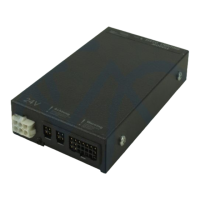MT
5.3.7.16 Damping Point / Turn Damping / Speed Damping
Parameter Possible Values Default Rev HHP Lite Std Adv
Damping Point 10 – 100 % 40 % -,A
Turn Damping 10 – 100 % 40% C -
Speed Damping 5 – 100 % 40 % C -
When the powerchair almost reaches its desired speed during acceleration or
deceleration, the acceleration/deceleration rate is slowly decreased to zero. This
prevents a sudden change in acceleration once the desired speed is reached. The
Damping Point parameter defines when the damping starts.
0%: No damping, 100%: Maximum damping.
For most applications the default value of 40% works fine.
UCM Software versions '–' and 'A' use only the Damping Point parameter: the same
value is used for Forward, Reverse and Turning.
In software version 'C' the Damping Point parameter has been replaced with two
separate parameters for added flexibility:
• Speed Damping (Damping point for forward and reverse)
• Turn Damping (Damping Point for turning).
Acceleration and deceleration
See also section 5.3.1.3:
.
Warning:
An unsuitably high or low value can make the powerchair unstable.
5.3.7.17 Min To Max Decel Ratio
Parameter Possible Values Default Rev HHP Lite Std Adv
Min To Max Decel Ratio 4 – 100 % 20 % -,A,C -
This parameter is used together with the
Damping Point / Turn Damping / Speed
Damping
parameters (5.3.7.16). Min To Max Decel Ratio defines the slope at the end
of the damping curve before the final speed is reached, as a percentage of the
acceleration / deceleration slope before damping has started.
4%: The end acceleration / deceleration is 4% of the acceleration / deceleration
before damping, which gives a very smooth curve.
100%: The end acceleration / deceleration is 100% of the
acceleration / deceleration before damping, which effectively results in no
damping at all.
Low values are smoother but will also cause more rollback when the powerchair stops
on a slope.
Acceleration and deceleration
See also section 5.3.1.3:
.
73

